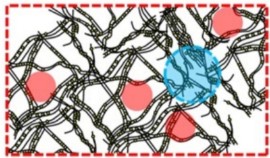the influence of the partial methyl-esterification of polygalacturonic acid (PGA) chains on the structure of ionotropic hydrogels
We investigated the influence of the partial methyl-esterification of polygalacturonic acid (PGA) chains on the structure of ionotropic hydrogels prepared with an external gelation protocol using calcium as the crosslinker and PGA chains with degrees of methylation (DM) of 0, 3, 18, and 34 %. Molar mass determination, viscosity, and small-angle neutron scattering measurements revealed that the methyl-esterification reaction employed reduces the molar mass (Mw) and the intrinsic viscosity, of the PGA chains and increases their overlap concentration, and their persistence length as DM increases. Moreover, the methylation induces turbidity in Ca-PGA hydrogels, which reflects the emergence of mesoscopic heterogeneities, reduces the gradients in PGA and calcium concentrations, as well as in Young’s modulus and increases the mesh size of the hydrogels. Complementary molecular dynamics simulations also showed that methylation promotes 31 helical conformations of PGA chains and reduces the length of junction zones between cross-linked PGA chains in the presence of calcium. Such effects likely originate from the presence of methyl-ester groups, which decreases the negative charge of methylated PGA chains, weakens their affinity for calcium, and promotes irregular association patterns.
https://www.sciencedirect.com/science/article/pii/S0144861725010860




